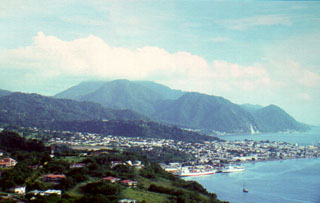Report on Morne Plat Pays (Dominica) — December 1998
Bulletin of the Global Volcanism Network, vol. 23, no. 12 (December 1998)
Managing Editor: Richard Wunderman.
Morne Plat Pays (Dominica) Tectonic earthquake swarm declines; no volcanic tremor or other activity
Please cite this report as:
Global Volcanism Program, 1998. Report on Morne Plat Pays (Dominica) (Wunderman, R., ed.). Bulletin of the Global Volcanism Network, 23:12. Smithsonian Institution. https://doi.org/10.5479/si.GVP.BGVN199812-360110
Morne Plat Pays
Dominica
15.255°N, 61.341°W; summit elev. 940 m
All times are local (unless otherwise noted)
The following explanation of the recent seismicity on Dominica (BGVN 23:11) was provided by John Shepherd of the Seismic Research Unit.
"There has indeed been a series of earthquakes in Dominica, West Indies, over the past few months. The sequence reached an apparent climax on 22-23 October 1998 when a total of about 370 earthquakes occurred, of which over 100 were felt. Since then earthquake numbers have declined irregularly with smaller maxima in numbers on 6 and 30 December 1998. At the present time (5 February 1999) the rate of activity has declined to a few earthquakes per week, which is about the background level which we have observed for the past 30 years.
"The earthquakes are part of a pattern which has continued for at least 250 years. The present earthquakes are NOT directly associated with Morne Patates or any other volcano in Dominica and there have been absolutely no other signs of volcanic activity. Dominica is in the center of the tectonically-active Lesser Antilles, and non-volcanic earthquakes are frequent. Dominicans refer to felt earthquakes as 'tremors.' This has no scientific significance; the earthquakes are conventional local earthquakes and no volcanic tremor has been recorded.
"There is undoubtedly a continuous volcanic hazard and many Dominicans have become concerned because this particular set of earthquakes follows closely on the recent events in the nearby island of Montserrat. For this reason the government of the Commonwealth of Dominica has conducted an intensive program of public awareness in which we have participated. We are also assisting in the preparation of an updated volcanic hazards map for Dominica."
Geological Summary. The Morne Plat Pays volcanic complex occupies the southern tip of the island of Dominica and has been active throughout the Holocene. An arcuate caldera that formed about 39,000 years ago as a result of a major explosive eruption and flank collapse is open to Soufrière Bay on the west. This depression cuts the SW side of Morne Plat Pays stratovolcano and extends to the southern tip of Dominica. At least a dozen small post-caldera lava domes were emplaced within and outside this depression, including one submarine dome south of Scotts Head. The latest dated eruptions occurred from the Morne Patates lava dome about 1270 CE, although younger deposits have not yet been dated. The complex is the site of extensive fumarolic activity, and at least ten swarms of small-magnitude earthquakes, none associated with eruptive activity, have occurred since 1765 at Morne Patates.
Information Contacts: John B. Shepherd, Head of Seismic Research, The University of the West Indies, St. Augustine, Trinidad.

